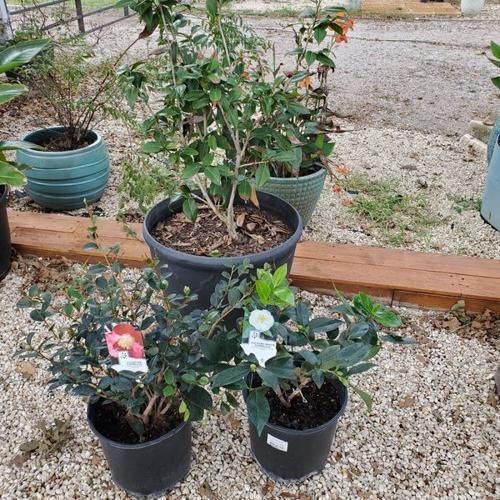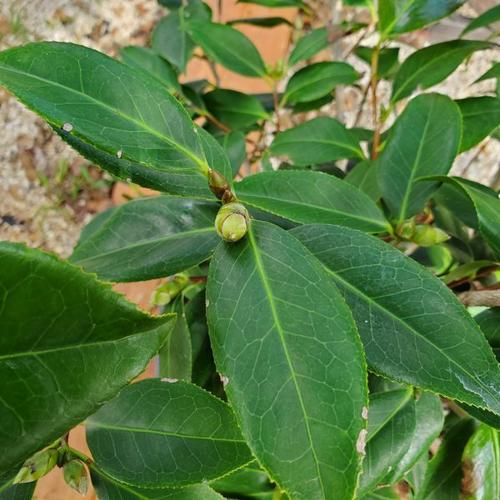Captivating camelias
- By Kristine Oksenholt / Victoria County Master Gardener
- Dec 23, 2023

Plant labels of newly purchased camellia.
Contributed photos by Kristine Oksenholt/ Victoria County Master Gardener

Texas camellia growth rate from one year after purchase and planted in a pot.
Contributed photos by Kristine Oksenholt/ Victoria County Master Gardener

Camellia bud and its leaves.
Contributed photos by Kristine Oksenholt/ Victoria County Master Gardener
Every camellia species has its own intrigue. Some species are known for their beautiful edible flower petals that have different scents and shapes. One species is known for its leaves that can be brewed into a hot or cold drink which is loved by many people.
The camellia is originally from the Eastern and Southern areas of Asia. The various camellia species are prized in many cultures not just for their beauty but also for their health benefits.
At first glance, one is struck by the beauty of the camellia flower and its evergreen foliage in contrast to the bleak dreary winter landscape. The camellia is often called the rose of winter or the queen of winter flowers for this reason.
Its bloom may resemble a rose, peony or anemone. The blooms might be single, double or semi-double and the colors appear primarily in white, pink, red, yellow or a combination of these colors.
There are at least 200 species and thousands of varieties of camellias. The Camellia Society in Georgia has a database with over 4.000 registered camellias since it began in 1945.
They bloom in three seasons. Camellia japonicas can reach 12 feet tall with unscented blooms occurring from December to March. Camellia sasanquas can reach 14 feet tall with scented blooms occurring October through January. Camellia reticulatas can reach 50 feet tall with very fragrant blooms occurring early May to late September.
Camellias are members of the tea family Theaceae. Camellia sinensis has tiny blooms in the fall but its leaves are dried and made into tea. The growing of this tea plant began in China and Japan.
In the 1800’s, Sir Lipton of Scotland had an idea to bring tea to America so he purchased land in South Carolina to grow tea plants. This acreage is now called the Charleston Tea Garden and is open to the public. He also bought a tea plantation in Sri Lanka and brought the tea leaves to America so everyone could enjoy tea.
Camellias are perennial treelike shrubs which prefer rich, well drained, acidic to neutral soil and are appropriate for hardiness zones seven through nine. They should be planted in spring or fall and watered often in the first year.
Camellias do well in light to partial shade. Planting under the shade of a tree or the north side of a house will help them flourish. As they get larger they can take more sunlight.
March, April and early May are the best months to fertilize after the blooms have gone and the plant needs energy for next year’s flowers. Camellias can be propagated from hardwood cuttings May through August.
Camellias can manage temperatures down to zero but they can lose buds and flowers in a hard freeze. Horticultural fleece helps to protect them from the cold. Avoid touching the fleece to the blooms and remove the fleece during the day.
Camellias can also be grown in pots. A 22-inch clay pot that is in a location of morning sun and afternoon shade will be fine for the camellia. A soil mixture of a half pot of sphagnum peat moss to a quarter pot of sharp builder’s sand and a quarter pot of compost is recommended.
None of the species of camellias are toxic if touched or consumed. The nontoxic flowers of camellia japonica are edible and contain antioxidants.
Camellia sinensis leaves are used to make white, green, black and oolong tea which have numerous health benefits when brewed into a drink. Its tea can boost the immune system and fight off inflammation. The camellia is truly captivating.
The Gardeners’ Dirt is written by members of the Victoria County Master Gardener Association, an educational outreach of Texas A&M AgriLife Extension – Victoria County. Mail your questions in care of the Advocate, P.O. Box 1518, Victoria, TX 77901; or [email protected], or comment on this column at VictoriaAdvocate.com.
REFERENCES:
- “8 secrets to get your camellias to bloom like crazy,” by Mickey Gast.
- “Camellias for Texas gardens,” Dr. William Welch Texas Agrilife Extension Service, www.aggie-hort.tamu.edu.
- “The complete guide to camellias,” by Steve Bender, www.southernliving.com.
- “6 little known camellia facts explain why this shrub is so popular,” by Lynn Coulter, www.bhg.com.
- “Things you didn’t know about green tea.” www.lipton.com.
- “Are camellias poisonous?.” www.plantaddicts.com.
- “Edible flowers for your garden and dinner table,” www.sfchronicle.com.
- “Grow your own ice tea,” by Brian Barth, www.modernfarmer.com.
- “All about camellias,” www.mizellscamelliahillsnursery.com.